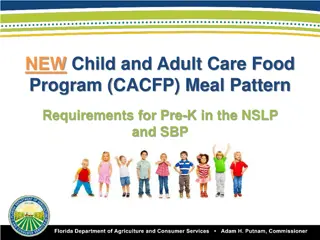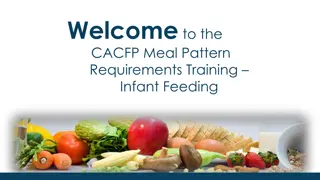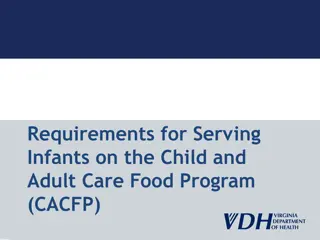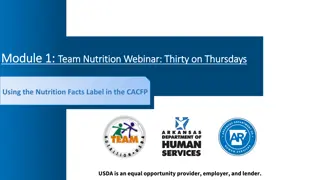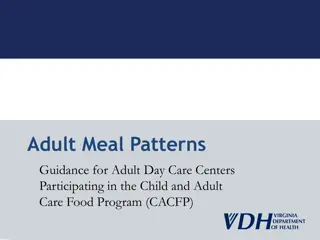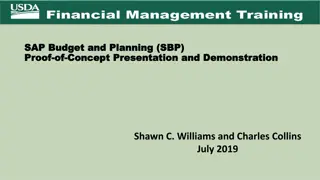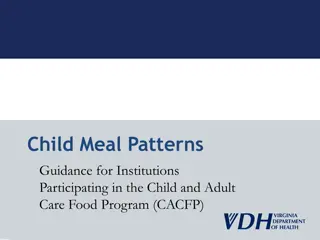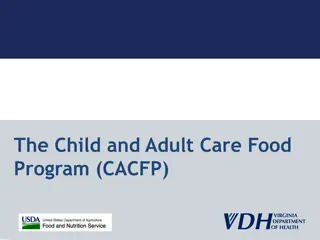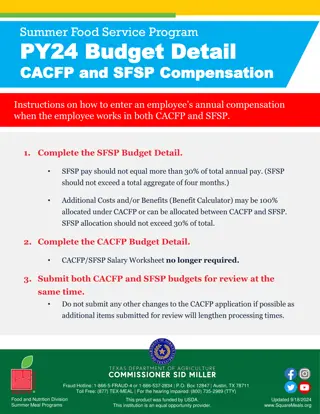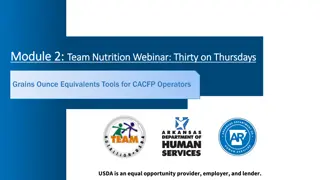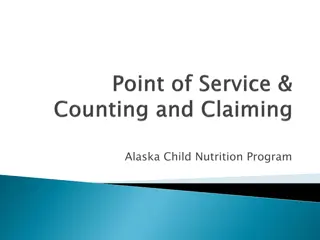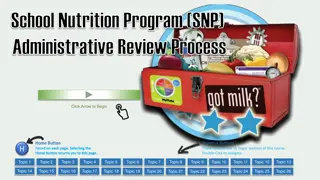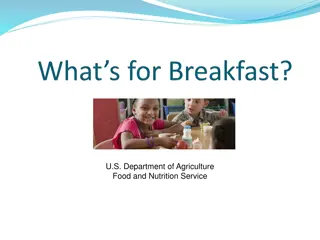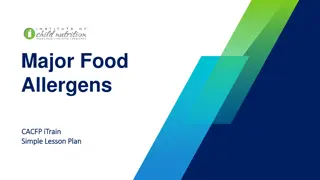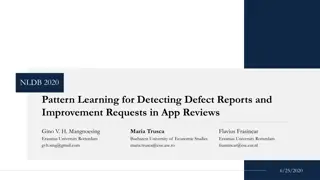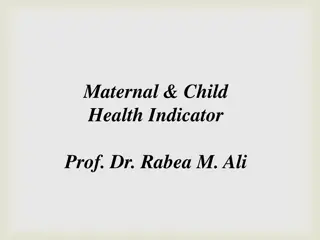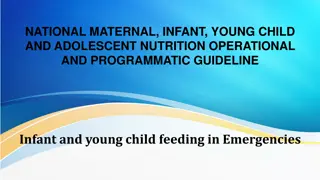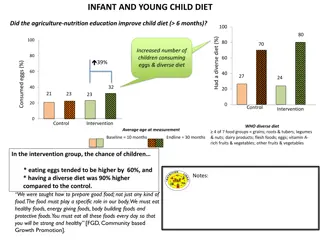New Infant Meal Pattern Requirements in the CACFP for NSLP and SBP
This training covers the new Infant Meal Pattern Requirements in the Child and Adult Care Food Program (CACFP) for infants in the National School Lunch Program (NSLP) and School Breakfast Program (SBP). It includes information on the regulatory process, implementation plan, two age groups for infants, flexibility in introducing solid foods, gradual introduction of solid foods, meal patterns for snacks, breakfast, lunch, and supper, as well as reimbursement guidelines for breastfeeding mothers.
Download Presentation

Please find below an Image/Link to download the presentation.
The content on the website is provided AS IS for your information and personal use only. It may not be sold, licensed, or shared on other websites without obtaining consent from the author. Download presentation by click this link. If you encounter any issues during the download, it is possible that the publisher has removed the file from their server.
E N D
Presentation Transcript
NEW Child and Adult Care Food Program (CACFP) Meal Pattern Requirements for Infants in the NSLP and SBP
Overview NEW Infant Meal Patterns USDA Questions & Answers Best Practices Test Your Knowledge *Please refer to the notes section at the bottom of each slide as you review this training.
Regulatory Process Comment period and development of final rule Proposed Rule published: January 15, 2015 Final Rule published: April 25, 2016 Implementation: October 1, 2017
Implementation Plan ALL sponsors serving infants (0 through 11 months) must be in compliance with the new infant meal pattern requirements discussed in this training by October 1, 2017. Sponsors may implement the new infant meal pattern requirements on the 1st day of the 2017-2018 school year. Reminder: Prior to October 1, 2017, implementation of any new meal pattern practices that conflict with the current infant meal pattern is not permitted.
NEW Infant Meal Patterns Two Age Groups 0-5 months 6-11 months Flexibility for introducing solid foods Before or after 6 months of age Allowed when infant is developmentally ready Sponsors should work with parents and guardians to determine what solid foods to serve and when.
NEW Infant Meal Patterns Snack Breakfast Lunch and Supper *Required when infant is developmentally ready All serving sizes listed are minimum quantities of the food components that are required to be served
Reimbursement for Breastfeeding Once all new infant meal pattern requirements are implemented meals will be eligible for reimbursement when a mother breastfeeds on-site. This includes meals when an infant is only consuming breastmilk. When a parent or guardian chooses to provide breastmilk or a creditable infant formula and the infant is consuming solid foods, the school must supply all the other required meal components in order for the meal to be reimbursable. Schools are strongly encouraged, but not required, to offer a quiet, private area that is comfortable and sanitary for mothers who come to the school to breastfeed. Expressed breastmilk may be stored at the school in a refrigerator at 40 F or below for no longer than 72 hours.
Key Takeaways: Birth-5 Months Age Group Only breastmilk or infant formula (or portions of both) can be served to infants 0 through 5 months. It is recommended that breastmilk be served in place of formula from birth through 11 months. Infant formula must be iron-fortified and regulated by the FDA. The FDA defines iron-fortified infant formula as a product which contains 1 milligram or more of iron in a quantity of a product that supplies 100 kilocalories when prepared in accordance with the label directions for infant consumption (21 CFR 107.10(b)(4)(i).
Defining Developmentally Ready for the 6-11 Months Age Group Beginning SY 2017-2018 (or by October 1, 2017) solid foods must be served to infants around 6 months of age as it is developmentally appropriate for the infant. The following guidelines from the AAP can help determine if an infant is developmentally ready to begin eating solid foods: The infant is able to sit in a high chair, feeding seat, or infant seat with good head control; The infant opens his or her mouth when food comes his or her way. He or she may watch others eat, reach for food and seem eager to be fed; The infant can move food from a spoon into his or her throat; and The infant has doubled his or her weight and weighs about 13 pounds or more.
Key Takeaways: 6-11 Months Age Group Breastmilk or infant formula (or portions of both) continue to be served to infants 6 though 11 months. Infant formula and dry infant cereal must be iron-fortified. Infant formulas and foods with added DHA are allowable. Vegetables and fruits are required to be offered at breakfast, lunch, supper and snack for infants that are developmentally ready to receive them. Juice cannot be claimed for reimbursement for meals served to infants of any age.
Key Takeaways: Meat/Meat Alternate 6-11 Months Age Group The new meal pattern allows cheese, cottage cheese, yogurt, and whole eggs to be served as a meat/meat alternate. Cheese food and cheese spread are not allowed under the new infant meal pattern due to their high sodium content. All yogurts served to infants must contain no more than 23 grams of sugar per 6 ounces.
Key Takeaways: Grains 6-11 Months Age Group All breakfast cereals served to infants must contain no more than 6 grams of sugar per dry ounce. Breakfast cereals include: ready-to-eat cereals, instant and hot cereals. Ready-to-eat breakfast cereals are now an additional grain option at snack. Sponsors are not required to serve infants whole grain-rich grain items; however, it is encouraged as a best practice.
Meal Components Parents Can Choose to Provide for Reimbursement Parents/guardians have the option to supply one component of the reimbursable meal such as expressed breastmilk or a creditable infant formula, even when the infant is only consuming breastmilk or formula. If an infant is developmentally ready to consume solid foods and the parent or guardian chooses to supply expressed breastmilk, a creditable infant formula, or directly breastfed on site, then the school must provide all other required meal components in order for the meal to be reimbursable. Alternatively, a parent or guardian may choose to provide a solid food component if the infant is developmentally ready. In this situation, the school must supply all of the other required meal components, including the iron-fortified infant formula.
USDA Questions and Answers: Feeding Infants
Questions and Answers What does it mean to feed an infant in a way that is consistent with the infant s eating habits? 1. Since infants do not eat on a strict schedule it is best to watch for hunger cues, and not the clock. As long as all the required food components are offered over the course of the day, the meals may be reimbursable. For example: Infant breastfed at home before arriving to school and is not hungry for the breakfast meal upon arrival. The school can choose to offer the meal to the infant later in the morning when the infant is hungry and still claim it. * As a reminder, infants do not need to consume the entire meal offered in order for the meal to be reimbursed.
Questions and Answers 2. How should meals be documented when a mother directly breastfeeds her infant on-site? USDA offers flexibility on how to document a meal when a mother directly breastfeeds her infant on-site. Schools are required to document the meal if the infant is served breastmilk or iron-fortified infant formula to demonstrate compliance with meal pattern requirements; however, they do not need to document the delivery method of the breastmilk (i.e. directly breastfed on-site or expressed breastmilk in a bottle). If an infant is served expressed breastmilk or infant formula from a bottle the school must document the quantity served to the infant. If an infant is breastfed on-site it is acceptable to simply indicate that the infant was breastfed on-site since the quantity served cannot be determined.
Questions and Answers 3. If a mother breastfeeds her 13 month old, or older, child at the school, is the meal reimbursable? Yes. Breastmilk is an allowable substitute for fluid milk for children of any age. Therefore, if a mother chooses to breastfeed her infant past 1 year of age she may breastfeed the child on-site or provide expressed breastmilk and the school may claim reimbursement for those meals. In addition, the school should count the breastmilk towards the meal that was closest to when the mother breastfed the child.
Questions and Answers 4. If a physician or recognized medical authority prescribes whole cow s milk as a substitute for breastmilk or infant formula for an infant younger than 12 months of age, is the meal reimbursable? For children younger than 12 months of age, cow s milk may be served as a substitute for breastmilk and/or infant formula, and be part of a reimbursable meal, if the substitution is supported by a medical statement signed by a recognized medical authority. The medical statement must explain the need for the substitution and must be kept on file by the school in order for the meal to be reimbursable.
Questions and Answers 5. If a parent chooses to provide infant formula and pre-mixes it at home, how is the school supposed to know if it the formula is iron-fortified? If a parent or guardian declines the iron-fortified infant formula that the school offers and they choose to provide their own infant formula, it is the responsibility of the school to inform the parent or guardian that they must provide a formula that is creditable (e.g. it is iron-fortified and is regulated by the FDA). A school may choose to have a form that indicates the parent or guardian declined the offered infant formula and that they will provide either breastmilk or an infant formula that is iron-fortified and is regulated by FDA. Or, a school may request the infant formula label to determine if it is iron-fortified; however, this documentation is not a Federal requirement.
Questions and Answers 6. Can solid foods be served to infants younger than 6 months of age? Yes. Meals containing solid foods are reimbursable when the infant is developmentally ready to accept them, even if the infant is younger than 6 months of age. A written note from a parent or guardian stating his or her infant should be served solid foods is recommended as a best practice, but is not required. Infants develop at different rates meaning some infants may be ready to consume solid foods before 6 months of age and others may be ready after 6 months of age. Schools are required to serve solid foods once an infant is ready to accept them. In general, infants should be consuming solid foods from all food groups (vegetables, fruits, grains, protein foods and dairy) by 7 to 8 months of age.
Questions and Answers 7. Is there a whole grain-rich requirement for infants participating in the NSLP and/or SBP? No. The requirement to serve at least one whole grain-rich food per day is only required under the new CACFP meal pattern guidelines for preschool (ages 1-4) and older age groups. 8. Can infant cereals be served in a bottle to infants? No. Serving infant cereal in a bottle to infants is not allowed. Neither the infant cereal nor the infant breastmilk or formula in the bottle may be claimed for reimbursement when they are served in the same bottle, unless it is supported by a medical statement.
Questions and Answers 9. Are commercially prepared mixed or combination foods (e.g., infant dinners with vegetables and chicken) reimbursable in the infant meal pattern? Commercially prepared mixed or combination foods that contain more than one food component are not reimbursable in the infant meal pattern. It is extremely difficult to identify the required food components and prove that the amount of the food components in mixed infant foods meet the meal pattern requirements. For example, an infant dinner with vegetables and chicken is not reimbursable. However, infant foods with more than one vegetable or fruit may be reimbursable because vegetables and fruit are one component under the infant meal pattern (e.g. sweet potatoes and bananas). Additionally, many commercially prepared mixed infant food products may have added sugar that may promote the development of tooth decay as well as provide few nutrients.
Questions and Answers 10. Are baby pouch food products allowed? The way a food is packaged does not impact whether a food is creditable or not. Commercially prepared infant foods that contain one food component and are packaged in a jar, plastic container, pouch or any other packaging are creditable. Providers should serve food from a pouch in the same way that it is served from a jar or plastic container, which is by using a spoon. Spoon-feeding is the most appropriate method for feeding pureed or mashed foods to infants. Infants benefit developmentally from the experience of eating from a spoon. Different tongue and lip motions are used for sucking than for eating from a spoon. Additionally, the American Academy of Pediatric Dentistry warns that sucking on baby food pouches may have the same negative effect as the practice of prolonged sucking of juice from bottles or sippy cups.
Best Practices Support mothers who choose to breastfeed their infants by encouraging mothers to supply breastmilk for their infants and offering a quiet, private area that is comfortable and sanitary for mothers who come to the school to breastfeed. Be in constant communication with infants parents or guardians about when and what solid foods should be introduced. Have parents or guardians request (in writing) when solid foods are to be introduced and keep the request on file.
Best Practices For infants 6 through 11 months: Limit serving processed meats to no more than one serving per week Choose low-fat or reduced-fat cheeses Offer whole grain-rich grains as often as possible Provide at least one serving from each vegetable subgroup weekly: Dark green vegetables Red and orange vegetables Beans and peas (legumes) Starchy vegetables Other vegetables
Best Practices For infants 6 through 11 months: Incorporate seasonal and locally produced foods into meals. Limit serving purchased pre-fried foods to no more than one serving per week. Avoid serving non-creditable foods that are sources of added sugars, such as sweet toppings (e.g., honey, jam, syrup) and mix-in ingredients sold with yogurt (e.g., honey, candy, or cookie pieces).
Test Your Knowledge! Question 1: True or False? All grains served to infants must be whole grain-rich. Question 2: True or False? Parents/guardians have the option to supply one component of the reimbursable meal. Question 3: True or False? The final rule only allows solid foods to be introduced after six months of age as the infant is developmentally ready for solid foods. Question 4: True or False? Juice cannot be claimed for reimbursement for meals served to infants of any age. Question 5: True or False? Meals are eligible for reimbursement when a mother breastfeeds on site, including meals when an infant is only consuming breastmilk (~0-5 months). Click the next slide to check your answers!
Test Your Knowledge! Question 1: All grains served to infants must be whole grain-rich. FALSE Question 2: Parents/guardians have the option to supply one component of the reimbursable meal. TRUE Question 3: The final rule only allows solid foods to be introduced after six months of age as the infant is developmentally ready for solid foods. FALSE Question 4: Juice cannot be claimed for reimbursement for meals served to infants of any age. TRUE Question 5: Meals are eligible for reimbursement when a mother breastfeeds on site, including meals when an infant is only consuming breastmilk (~0-5 months). TRUE
Questions? Jamie Burch, RD, LD/N, SNS Nutrition Standards Director (850) 617-7448 | Jamie.Burch@freshfromflorida.com Brittany Lord, RDN, LD/N Nutrition Standards Program Specialist (850) 617-7453| Brittany.Lord@freshfromflorida.com This institution is an equal opportunity provider.


